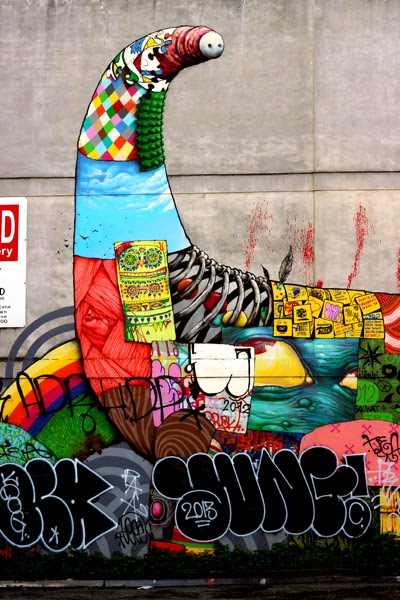This is a great street art composition I found down China Town. I love the vibrant colours and the use of pattern. To me it looks like a patchwork quilted monster, in the way they have divided up sections of the body with different patterns and colours. It's a bit of a pity that people have tagged over the top of it, but that's the nature of street art.
Love
Mosey x
Sunday, 20 October 2013
Friday, 18 October 2013
Progress
The subject of 'progress' is an interesting topic, with everyone having their own opinion.
While studying my degree in archaeology we were frequently presented with the ideas of progress, preservation and conservation, and the precarious balance between these issues.
In archaeology we are taught the harsh truth that in its nature archaeology is destruction. In order to learn and discover we must pull apart and destroy the site. This of course means that a strict code of ethics must be applied to all archaeological research, which also includes consideration for preservation and/or conservation measures. Here in Melbourne, Heritage Victoria and the National Trust have a say in the outcome of archaeological sights and historically important buildings. But as to be expected there are always many interest groups involved.
These kinds of ethical and moral questions can be applied to older architecture, and the way in which it affects our changing urban landscape.
It is impossible and unrealistic to keep all our beautiful old buildings. If we were to try, it would hinder progress and new developments in design, building techniques and technology. As time passes our wants and needs, as well as the way we use and relate to spaces changes. Older buildings aren't always practical or usable in their original intent or purpose. Does that in a moral sense make it ok to change the building or to even demolish it? What types of buildings are worthy of keeping in tact? Who decides upon the criteria in which these buildings are subject to?
These types of questions may seem slightly absurd or petty when thinking of an unused 1940s office building, or the run down Federation style home in the street next to yours. However they are important things to consider in a holistic sense. If no one is considering these things, and we all rush out and knock down every old home or change every heritage building to the point where they are no longer recognisable, we will lose all our history and the opportunity to discover and learn about our past.
I'm not saying we need to go to the extremes of opposing every new development, but just some thought, consideration and care needs to be applied. The two most important questions to ask are, how will this change our urban landscape, and is what will be replacing the original building or structure worthy to be put in its place?
It is these questions of progress, preservation and conservation that I ask myself when I see an old building, particularly when new development is proposed or has begun. Perhaps these are some things you can ponder as you look at the photos on this blog and when you see progress happening in your own local area.
Love
Mosey x
 |
| Right side details showing 'scaring' effect on the brick work as a result of the demolished building. |
 |
| Details showing the resulting effects on the brickwork on the standing building. If you look closely you can see the outline of the demolished building. |
 |
| Construction site on the corner of Lonsdale and Russell Streets. You can see modern additions to the older building on the left of the construction site. |
 |
| Back view of the front facade of the old Lonsdale Street Myer building. You can see the way the facade is being held up while each interior levels are built up. |
Tuesday, 1 October 2013
Street Art
Street art is something I have not explored on my blog yet, and may seem a bit left of centre compared to my previous posts. However it is one of those things that you stumble across when you are out and about, which is the overarching theme of this blog.
As a snapshot in time, street art will probably become an important indicator and/or way to trace social history in the future; not only through artistic styles, but through the themes and subject matter and how that relates to the issues of our time.
These pictures were taken down Croft Alley, which is off Little Bourke Street in China Town. Very much hidden away, it was exciting to see so many different styles, compositions and colours together in this space.
Love
Subscribe to:
Comments (Atom)










